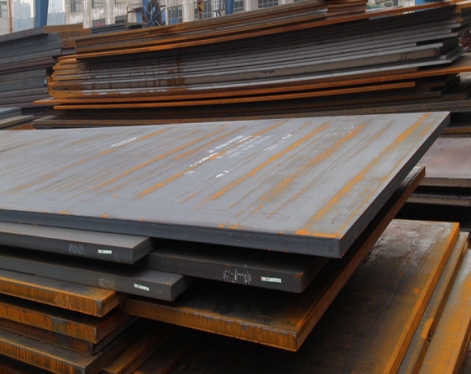1.What is ar steel plate?
Wear-resistant steel plate is a special plate designed for large-area wear environments. This type of steel plate is usually based on ordinary low-carbon steel or low-alloy steel with good toughness and plasticity. A layer of material with high hardness and strong wear resistance is added to its surface through a surfacing process to make a plate product with excellent wear resistance.The main material of the wear-resistant plate is steel, and the main components are low-carbon steel plate and alloy wear-resistant layer. Among them, the alloy wear-resistant layer occupies 1/2~1/3 of the thickness of the entire plate, and the main chemical component is chromium. It can reach 20%~30% of the content of all materials. The surface hardness is very high, and the wear resistance is also very good, and the service life is long.
2.What do the 'AR' numbers in steel plate grades signify?
AR is the abbreviation of "abrasion resistant", and the number after AR refers to the Brinell hardness value. For example, the "500" in AR500 steel plate means that the Brinell hardness value of this steel plate is about 500. This value is obtained based on the Brinell hardness test. Brinell hardness is a standard for indicating the hardness of a material. It is measured by a Brinell hardness tester. It was first proposed by the Swede J.A. Brinell, so it is called Brinell hardness. A hardened steel ball with a diameter of D is pressed into the surface of the metal material under test with a certain load P, and the load is removed after a period of time. The ratio of the load P to the indentation surface area F is the Brinell hardness value, recorded as HB.
3.What is ar400 steel?
AR400 steel is a medium-hard, high-wear-resistant steel, mainly composed of carbon, manganese and silicon. The hardness of this steel can reach 400 Brinell hardness.
4.What is ar500 steel?
Due to its high hardness and wear resistance, AR500 steel plates are usually used in situations requiring extremely strong wear resistance, such as bulletproof steel plates, wear-resistant parts of heavy machinery, etc.
5. AR400 Vs AR500 steel plate
| Attribute | AR 400 Steel Plate | AR 500 Steel Plate |
|---|---|---|
| Hardness | Nominal hardness of 400 Brinell (HB). Suitable for moderate to heavy wear resistance applications in mining, construction, and material handling equipment. | Higher nominal hardness of 500 Brinell. Used where extreme abrasion resistance is necessary, such as in shooting targets, armored vehicles, and mining equipment. |
| Cracking | Higher toughness and ductility compared to AR 500. Less prone to cracking under high-impact or dynamic loading conditions but can still experience cracking under extreme stress or improper use. | More prone to cracking with impact than AR 400. Suitable for sliding abrasion in agricultural, manufacturing, and mining machinery and equipment. |
| Applications | Commonly used where moderate abrasion resistance is needed. Found in dump truck bodies, crushers, hoppers, and chutes. | Preferred for applications requiring a higher level of abrasion resistance. Used for ballistic plates, shooting targets, and armor plating. |
| Machinability | Generally more readily machinable due to its lower hardness. | Machinable but more challenging compared to lower grades. Requires appropriate cutting tools, techniques, and machining parameters. |
| Weldability | Can be welded using appropriate procedures. Precautions needed to avoid excessive heat input that can affect hardness and performance. | Can be welded with appropriate procedures. Care must be taken to avoid heat input that can compromise hardness and performance. |









